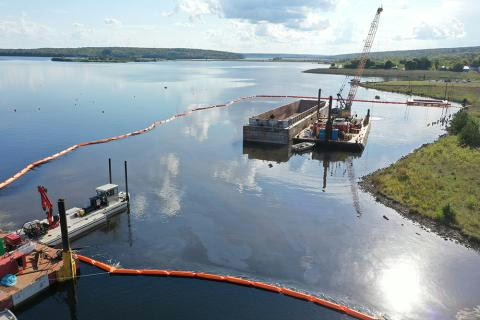Category: Other
GLRI grant improves soil, helps protect water quality in Ohio
GLRI grant improves soil, helps protect water quality in Ohio
josterme01
Thu, 11/21/2024 – 1:53 pm
A $193,500 USDA Forest Service Great Lakes Restoration Initiative grant is helping maintain and improve water quality in Euclid, Ohio. The grant to Cleveland Metroparks is allowing partners to plant trees, reduce soil compaction and enhance a riparian buffer along Euclid Creek. More information about the project.
GLRI grant improves soil, helps protect water quality in Ohio
GLRI grant improves soil, helps protect water quality in Ohio
josterme01
Thu, 11/21/2024 – 1:53 pm
A $193,500 USDA Forest Service Great Lakes Restoration Initiative grant is helping maintain and improve water quality in Euclid, Ohio. The grant to Cleveland Metroparks is allowing partners to plant trees, reduce soil compaction and enhance a riparian buffer along Euclid Creek. More information about the project.
Thu, 11/21/2024 – 1:53 pm
A $193,500 USDA Forest Service Great Lakes Restoration Initiative grant is helping maintain and improve water quality in Euclid, Ohio. The grant to Cleveland Metroparks is allowing partners to plant trees, reduce soil compaction and enhance a riparian buffer along Euclid Creek. More information about the project.
Thu, 11/21/2024 – 1:53 pm
Community raises issues during public meeting for zoning bylaw review
(By Pauline Kerr) The public meeting for the comprehensive zoning bylaw review included a presentation by Tessa Gerling of the Philosopher’s Wool Environmental Preserve group (PWEP), as well as questions … Continue reading Community raises issues during public meeting for zoning bylaw review
The post Community raises issues during public meeting for zoning bylaw review appeared first on Kincardine Independent.
GLRI Funds Help Pollinators Thrive on Finger Lakes National Forest
GLRI Funds Help Pollinators Thrive on Finger Lakes National Forest
josterme01
Fri, 11/15/2024 – 1:43 pm

Finger Lakes National Forest staff and partners were able to replace invasive grasses at Backbone Campground, Overlook Trailhead, and the parking area at Caywood Point with native species, thanks to funding from the Great Lakes Restoration Initiative.
Partners were also key in restoring the areas for pollinators. The USDA Plant Materials Center provided short term seed storage prior to propagation, space to prepare seeds for planting, greenhouse space to grow about 2,000 plugs, and expertise in in the field. In addition, a crew Finger Lakes Community College and a crew from CorpsTHAT!, a program dedicated to connecting the Deaf Community and the outdoors through education, recreation, and careers, helped put the new plants in the ground.
The species of native forbs and grasses planted will provide pollinators with nectar through the growing season as well as habitat to overwinter in the stems and leaf litter of the newly planted species.
EPA completes Drum Removal Pilot Study in the Hubbell Processing Area of the Torch Lake Area of Concern
EPA completes Drum Removal Pilot Study in the Hubbell Processing Area of the Torch Lake Area of Concern
josterme01
Wed, 11/13/2024 – 1:39 pm

This fall the U.S. Environmental Protection Agency completed a Drum Removal Pilot Study in the Hubbell Processing Area (HPA) of the Torch Lake Area of Concern (AOC). The work was performed as part of the Great Lakes Legacy Act sediment and drum remediation as a partnership between EPA and Honeywell International, in close coordination with the Michigan Department of Environment, Great Lakes, and Energy and other community stakeholders.
As part of past evaluations and work performed by EPA and Honeywell, over 400 metal 55-gallon drums have been identified on the lakebed of Torch Lake in the HPA at various water depths, ranging from approximately 20 feet to over 70 feet in depth. Drums noted during underwater video surveys appear in various stages of deterioration with contaminated sediment present in the area of the drums.
EPA’s contractors removed approximately 100 drums as well as debris and contaminated sediment from three areas at differing water depths.
Turbidity curtains and bubble curtains, which help control residual sediment movement during dredging, were in place throughout drum and sediment removal operations. Extensive monitoring was performed during dredging activities that will help in the development of a larger cleanup project. Drums, debris and sediment removed were temporarily staged prior to be transported to a disposal facility.
The in-water portion of the pilot study was completed in late September with material transportation to the landfill completed in early November. The Drum Removal Pilot Study will assist in the evaluation of drum removal and cleanup options at various water depths, which is a critical component of the ongoing Torch Lake HPA Feasibility Study.
Learn more about remediation and restoration work in the Torch Lake AOC.









